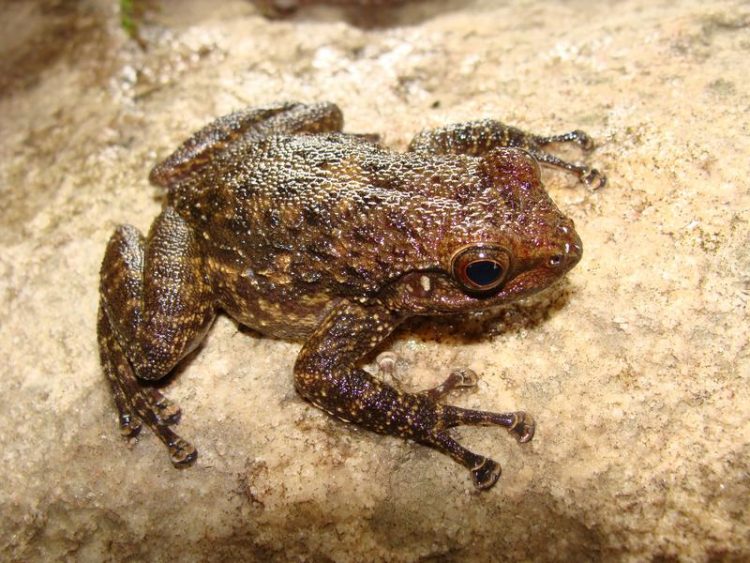Tooth-frogs – Life in the fast spray zone: Four new endemic species in West African Forests

Tooth-frog species Odontobatrachus fouta – named after the Fouta Djallon highland region in the Republic of Guinea, West Africa, a region with most probably more undescribed tooth-frog species. Museum für Naturkunde Berlin (MfN)
Due to their habitat needs, currents in primary rain forests, and small distribution ranges, all tooth-frog species are at risk of extinction through ongoing habitat loss and require immediate conservation efforts. The paper is available in the open-access journal Zoosystematics and Evolution published by the Museum für Naturkunde Berlin.
The single West African tooth-frog species Odontobatrachus natator has only last year been recognized as representing a unique vertebrate family endemic to the forests of Upper Guinea. Recently, with molecular techniques, Dr. Michael Barej from the Museum für Naturkunde Berlin and his colleagues uncovered the possible existence of a complex of cryptic species.
In the featured work, this team assessed the morphological variation of all known populations of West African tooth-frogs and verified the presence of four species new to science. These insights are crucial for the conservation of the Upper Guinean biodiversity hotspot and highlight its vulnerability. All new species in this unique, endemic family are highly endangered.
A unique morphology with e.g. presence of their name-bearing tusk-like appendages in the lower and curved teeth in the upper mandible in adults or a sucker-like mouth in tadpoles, distinguishes West African tooth-frogs from all remaining frog families. However, due to a strong overall morphological similarity between all known populations, only a single species, O. natator, has been recognized for more than a century throughout the forests of West Africa.
Recently new analyses revealed an unexpected high genetic variation. This and complementary biogeographical patterns made the presence of additional species in this presumed monospecific (comprising only one species) frog family likely. The description of four new species by Dr. Barej’s team is based on combinative analyses of genetics and morphological characters.
The increase of species in this unique lineage and their distribution pattern further encourages other researchers to search for cryptic and undescribed species in the forests of the Upper Guinean biodiversity hotspot. Barej and colleagues also claim that “recognition and description of species is just a first step which provides the baseline for subsequent studies to gather further data on the ecology or behaviour – or simply: naming does not mean knowing a species”.
The presented results call for the IUCN Red List category “Endangered” for all of the newly described species. These frogs occur along strong currents, cascades and waterfalls in the few remaining patches of primary forests in West Africa.
The researchers fear that all “West African torrent-frog species are at risk of becoming extinct because of habitat loss in the Upper Guinean biodiversity hotspot, whose “true” biodiversity is still far from being completely known”. The study is published in the open-access journal Zoosystematics and Evolution published by the Museum für Naturkunde Berlin.
Original publication:
Michael F. Barej, Andreas Schmitz, Johannes Penner, Joseph Doumbia, Laura Sandberger-Loua, Mareike Hirschfeld, Christian Brede, Mike Emmrich, N’Goran Germain Kouamé, Annika Hillers,7, Nono L. Gonwouo, Joachim Nopper, Patrick Joël Adeba, Mohamed A. Bangoura, Ceri Gage, Gail Anderson, Mark-Oliver Rödel (2015): Life in the spray zone – overlooked diversity in West African torrent-frogs (Anura, Odontobatrachidae, Odontobatrachus). Zoosyst. Evol. 91 (2): 115–149. DOI 10.3897/zse.91.5127
Media Contact
All latest news from the category: Life Sciences and Chemistry
Articles and reports from the Life Sciences and chemistry area deal with applied and basic research into modern biology, chemistry and human medicine.
Valuable information can be found on a range of life sciences fields including bacteriology, biochemistry, bionics, bioinformatics, biophysics, biotechnology, genetics, geobotany, human biology, marine biology, microbiology, molecular biology, cellular biology, zoology, bioinorganic chemistry, microchemistry and environmental chemistry.
Newest articles

A universal framework for spatial biology
SpatialData is a freely accessible tool to unify and integrate data from different omics technologies accounting for spatial information, which can provide holistic insights into health and disease. Biological processes…

How complex biological processes arise
A $20 million grant from the U.S. National Science Foundation (NSF) will support the establishment and operation of the National Synthesis Center for Emergence in the Molecular and Cellular Sciences (NCEMS) at…

Airborne single-photon lidar system achieves high-resolution 3D imaging
Compact, low-power system opens doors for photon-efficient drone and satellite-based environmental monitoring and mapping. Researchers have developed a compact and lightweight single-photon airborne lidar system that can acquire high-resolution 3D…





















